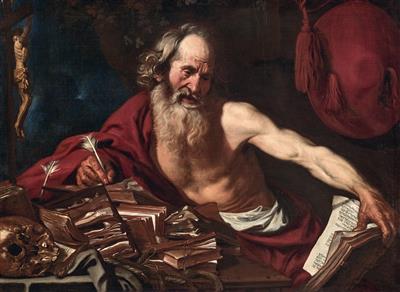Joost Van de Hamme

(Brussels, circa 1630 – circa 1657)
Saint Jerome,
signed lower center: Joost van Hamme Bruxell./Faciebat 1654 xi Apr.,
oil on canvas, 85 x 118 cm, framed
Provenance:
Private European collection, since at least 1950
Literature:
G. Bocchi, U. Bocchi, Naturalia: nature morte in collezioni pubbliche e private, Casalmaggiore 1992, pp. 362–363, pl. 130
The few paintings in the corpus of works by Joost van de Hamme are mostly signed. Bocchi has suggested that he should be called a ‘caravaggesco di buona razza’ – a Caravaggist of good breeding – using a term that derives from the Caravaggio scholar Roberto Longhi to describe the best followers of Caravaggio (see literature). His ability in figurative painting, as well as the importance he placed on compositional structure and the description of still life objects are clearly demonstrated in the present work.
In this composition, it could be argued that the artist indulges himself in the description of the objects displayed. Here, books with crumpled pages, quills and an inkwell clearly exceed the normal iconography used when depicting Saint Jerome, who is mostly shown with a single book. Van de Hamme’s interpretative freedom goes as far as to give the church father an even more cultured and literary character, pertinent for a doctor of the church otherwise known as the ‘Christian Cicero’. The present composition also includes various other symbols that relate to the typical iconography of the Saint. The pilgrim’s staff, the tasseled cardinal’s hat, as well as the skull, are all included, however the lion, which often accompanies the hermit, is not depicted.
The attention given to the rendering of objects in the present composition can be compared to a painting depicting an Old Man with Fruit published by Salerno, which was originally part of a series (see L. Salerno, La natura morta italiana, Rome 1984, p. 408, no. 241). Saint Jerome’s figure is stylistically close to the work of Caravaggio. The attention given to the objects in the composition, lit by strong directional light, suggests a material reality, with the luminous intensity filtered through the pages of the crumpled books, creating the sense of thickness and the consistency of parchment. In this way, the observation of realism in this composition conforms to interest in the cannons of tenebrism, which Van de Hamme may have acquired during a possible stay in Italy, which has been suggested by works such as the present painting.
30.04.2019 - 17:00
- Realized price: **
-
EUR 320,500.-
- Estimate:
-
EUR 80,000.- to EUR 100,000.-
Joost Van de Hamme
(Brussels, circa 1630 – circa 1657)
Saint Jerome,
signed lower center: Joost van Hamme Bruxell./Faciebat 1654 xi Apr.,
oil on canvas, 85 x 118 cm, framed
Provenance:
Private European collection, since at least 1950
Literature:
G. Bocchi, U. Bocchi, Naturalia: nature morte in collezioni pubbliche e private, Casalmaggiore 1992, pp. 362–363, pl. 130
The few paintings in the corpus of works by Joost van de Hamme are mostly signed. Bocchi has suggested that he should be called a ‘caravaggesco di buona razza’ – a Caravaggist of good breeding – using a term that derives from the Caravaggio scholar Roberto Longhi to describe the best followers of Caravaggio (see literature). His ability in figurative painting, as well as the importance he placed on compositional structure and the description of still life objects are clearly demonstrated in the present work.
In this composition, it could be argued that the artist indulges himself in the description of the objects displayed. Here, books with crumpled pages, quills and an inkwell clearly exceed the normal iconography used when depicting Saint Jerome, who is mostly shown with a single book. Van de Hamme’s interpretative freedom goes as far as to give the church father an even more cultured and literary character, pertinent for a doctor of the church otherwise known as the ‘Christian Cicero’. The present composition also includes various other symbols that relate to the typical iconography of the Saint. The pilgrim’s staff, the tasseled cardinal’s hat, as well as the skull, are all included, however the lion, which often accompanies the hermit, is not depicted.
The attention given to the rendering of objects in the present composition can be compared to a painting depicting an Old Man with Fruit published by Salerno, which was originally part of a series (see L. Salerno, La natura morta italiana, Rome 1984, p. 408, no. 241). Saint Jerome’s figure is stylistically close to the work of Caravaggio. The attention given to the objects in the composition, lit by strong directional light, suggests a material reality, with the luminous intensity filtered through the pages of the crumpled books, creating the sense of thickness and the consistency of parchment. In this way, the observation of realism in this composition conforms to interest in the cannons of tenebrism, which Van de Hamme may have acquired during a possible stay in Italy, which has been suggested by works such as the present painting.
|
Buyers hotline
Mon.-Fri.: 10.00am - 5.00pm
old.masters@dorotheum.at +43 1 515 60 403 |
| Auction: | Old Master Paintings |
| Auction type: | Saleroom auction |
| Date: | 30.04.2019 - 17:00 |
| Location: | Vienna | Palais Dorotheum |
| Exhibition: | 20.04. - 30.04.2019 |
** Purchase price incl. charges and taxes
It is not possible to turn in online buying orders anymore. The auction is in preparation or has been executed already.
